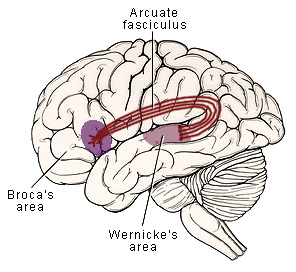Broca's area
From Psy3241
Broca's area is the area in the brain that is responsible for speech production, language processing, and language comprehension. Broca's area was first discovered in 1861 by Pierre Paul Broca, after studying the postmortem brain of Monsieur LeBorgne, commonly known as Tan, a patient of his who had a speech impediment.
Contents |
Description
Broca's area is located in the left frontal lobe, around the opercular and triangular sections of the inferior frontal gyrus. It is connected to Wernicke’s area of the brain by the arcuate fasciculus, which is a pathway made of neurons. (see below).
Parts
Broca's area contains two main parts: the Pars triangularis and the Pars opercularis.
The Pars triangularis is located in the anterior part of Broca's area. Researchers believe that this area of the brain is responsible for helping the human brain interpret different stimulus modes. It also supports the programming of verbal conducts.
The Pars opercularis is located in the posterior part of Broca's area. It is believed that this area supports only one stimulus mode, rather than multiple modes like the Pars triangularis. This portion of Broca’s area is also believed to coordinate the organs used for speech in order to produce language.
Damage to Broca's area
If Broca's area is damaged, people will usually suffer from a condition called Broca's aphasia. This condition is also sometimes called expressive aphasia, nonfluent aphasia, or motor aphasia. Broca's aphasia makes people unable to create sentences that are grammatically complex. In addition, the sentences usually contain very few words related to content. Broca's aphasia is characterized by nonfluent speech, few words, short sentences, and many pauses.
For example, if a Broca's aphasic was trying to explain how he came to the hospital for dental surgery, it might sound like this:
"Yes... ah... Monday... er... Dad and Peter H... (his own name), and Dad.... er... hospital... and ah... Wednesday... Wednesday, nine o'clock... and oh... Thursday... ten o'clock, ah doctors... two... an' doctors... and er... teeth... yah."
Despite the Broca's aphasic's difficulty in putting together sentences, a person with a damaged Broca's area is generally capable of comprehending language without a problem. Sometimes, however, the person may have difficulty with understanding a few words used in a sentence with complex syntax. These people typically have damage only in the posterior part of Broca's area, a condition called Wernicke’s aphasia. Those suffering from Wernicke’s aphasia may have somewhat normal speech, though it tends to be vague or even meaningless.

